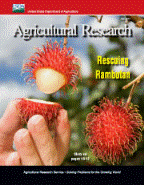United States Department of Agriculture: Agricultural Research Service, Lincoln, Nebraska

Agricultural Research Magazine
Date of this Version
1-2013
Document Type
Article
Citation
Agricultural Research January 2013
Abstract
More than 1 million tons of sugar beet pulp are generated annually by U.S. beet sugar industries. Finding profitable uses for the biodegradable pulp, which is the leftover residue from sugar extraction, is critical for the long-term economic viability of U.S. agribusiness.
Agricultural Research Service researchers and colleagues have long been studying the potential of sugar beet pulp utilization. Now, chemist LinShu Liu and plant physiologist Arland Hotchkiss, both with the Dairy and Functional Foods Unit at ARS’s Eastern Regional Research Center in Wyndmoor, Pennsylvania, and colleagues have found new uses for sugar beet pulp.
In collaboration with professor Jinwen Zhang of Washington State University (WSU) in Pullman, Liu and ARS-WSU colleagues developed a biodegradable thermoplastic (meaning plastic that becomes soft when heated) that could be used in disposable food containers. The bioplastic is manufactured from both sugar beet pulp and a biodegradable polymer called polylactic acid, or PLA, using a twin screw extruder. PLA is a commercially available polymer derived from the sugars in corn, sugar beet, sugarcane, switchgrass and other plants—renewable feedstocks. Extrusion is a cost-effective manufacturing process that is popularly used in large-scale production of food, plastics, and composite materials. Many biopolymers and their composite materials with petroleum-based polymers also can be extruded.
The scientists showed that up to 50 percent sugar beet pulp can be incorporated with PLA, and the resulting thermoplastic composites retain mechanical properties similar to those of polystyrene and polypropylene—the compounds used to make white, spongy food packages. The new thermoplastic is cost competitive with commonly used petrochemical plastics. The study was published in Industrial & Engineering Chemistry Research in 2008.
ARS-WSU researchers also developed other sugar beet pulp materials. Under extrusion compounding, sugar beet pulp was turned into a thermoplastic-like material with the assistance of water and/or glycerol. This material can be subsequently processed by extrusion or injection molding to produce neat (meaning pure) sugar beet pulp products.
Included in
Agriculture Commons, Animal Sciences Commons, Food Science Commons, Plant Sciences Commons

